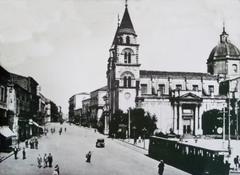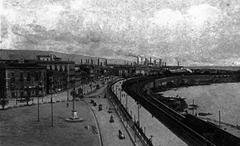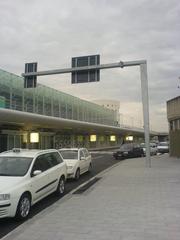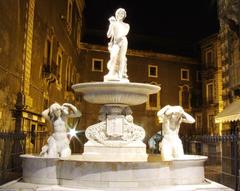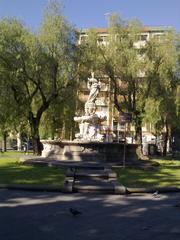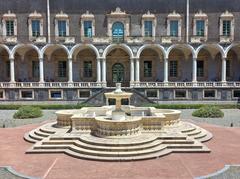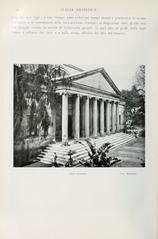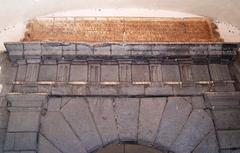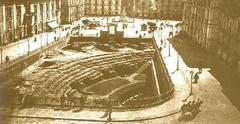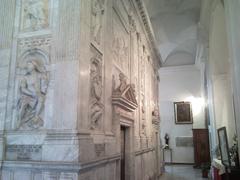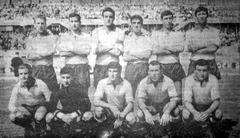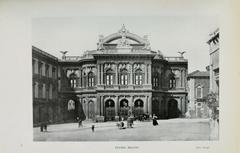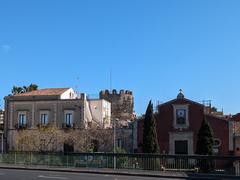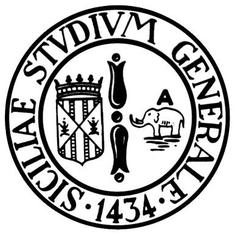Casa Vaccarini Visiting Hours, Tickets, and Catania Historical Sites Guide
Date: 14/06/2025
Introduction
Nestled in the heart of Catania, Sicily, Casa Vaccarini stands as a distinguished emblem of Sicilian Baroque architecture and a testament to the vision of Giovanni Battista Vaccarini—the architect who played a pivotal role in reshaping Catania after the devastating 1693 earthquake. This guide provides an in-depth look at Casa Vaccarini’s history, architectural features, and cultural significance, alongside practical information on visiting hours, ticketing, accessibility, and nearby attractions. Whether you are an architecture enthusiast, history buff, or cultural traveler, this resource will help you plan a rewarding visit to one of Catania’s most important historical sites (Italia.it, Wikipedia, Cataniablog).
Table of Contents
- Introduction
- Historical Context and Significance
- Architectural Features and Innovations
- Planning Your Visit
- Nearby Attractions & Amenities
- Practical Visitor Tips
- Frequently Asked Questions (FAQ)
- Conclusion
- References
Historical Context and Significance
Catania’s Baroque Rebirth
Following the catastrophic 1693 earthquake, Catania underwent a dramatic transformation, emerging as a showcase of Sicilian Baroque urbanism. Local black lava stone from Mount Etna and white marble became hallmarks of the city’s new architectural identity, resulting in visually striking bichrome facades and monumental public spaces (Italia.it; Zainoo).
Giovanni Battista Vaccarini’s Legacy
Giovanni Battista Vaccarini (1702–1768), trained in Rome and influenced by Borromini, Bernini, and other Baroque masters, became the chief architect of Catania’s post-earthquake reconstruction. Appointed city architect in 1730, Vaccarini blended Roman Baroque exuberance with local materials and traditions, leaving his mark on palaces, churches, and civic buildings that define the city’s historic core (Wikipedia, Italian Art Society).
Casa Vaccarini—considered his residence and a microcosm of his architectural ideals—stands today as a symbol of Catania’s resilience, innovation, and Baroque splendor (Cataniablog).
Architectural Features and Innovations
Exterior and Materials
- Façade: The building features a striking contrast of black lava stone and white limestone or marble, a hallmark of Catania’s Baroque style (Italia.it).
- Ornamentation: Elaborate balconies with wrought-iron railings, sculpted window surrounds, and grand entrances define the exterior. Broken pediments and free-standing columns reflect Vaccarini’s innovative approach (Wikipedia).
Interior and Layout
- Spatial Drama: Expect lavish Baroque interiors with frescoed ceilings, gilded stucco, and dramatic staircases—particularly the double staircase, a Vaccarini signature (The Design Gesture).
- Layout: The two-story, nearly square building features a raised main entrance, four ground-floor rooms, and ten small upper-floor rooms plus a salon, exemplifying elite residential life in 18th-century Catania (VirtualSicily).
Integration with Urban Fabric
Casa Vaccarini is not an isolated monument but part of Catania’s coordinated Baroque urban landscape, with its facades and spatial alignments contributing to the harmony of surrounding streets and piazzas (Zainoo).
Planning Your Visit
Location & Access
- Address: Via Luigi Sorrentino 38, Civita district, Catania, Italy (WhichMuseum).
- Getting There: Walkable from Piazza del Duomo and Via Crociferi; accessible by AMT bus (nearest stops: Via Vittorio Emanuele II, Via Plebiscito). Limited parking available near city center; taxis and ride-hailing apps are convenient (VoyageTips).
Visiting Hours & Tickets
As of June 2025:
- Hours: Not consistently published; museum may be temporarily closed for restoration or administrative reasons. Always check with the Catania tourist office or official sources before planning your visit (WhichMuseum).
- Tickets: No fixed pricing or online booking. Admission may be free or require a nominal fee; inquire locally.
- Group Visits/Guided Tours: Can be arranged through the Catania tourist office or local cultural associations.
Facilities & Accessibility
- Accessibility: Due to its historic structure (raised entrance, lack of elevators or ramps), accessibility for visitors with mobility impairments is limited.
- Restrooms: Not guaranteed on-site; use nearby cafes or museums.
- Photography: Policies may vary; inquire at the entrance.
Guided Tours & Events
- Guided Tours: Available on request via local agencies or cultural offices, with expert commentary on Vaccarini’s work.
- Special Events: Casa Vaccarini occasionally hosts exhibitions and cultural programs. Check VirtualSicily for updates.
Photography Policy
- Personal Use: Generally permitted inside (no flash); professional equipment requires prior permission.
Nearby Attractions & Amenities
- Benedictine Monastery of San Nicolò l’Arena: A UNESCO-listed Baroque masterpiece (TheCrazyTourist).
- Museo Civico at Castello Ursino: Showcases Catania’s history and art (PlanetWare).
- Piazza del Duomo: Central square with the iconic Elephant Fountain and Catania Cathedral.
- Via Crociferi: Famed Baroque street with multiple Vaccarini-designed churches (Lonely Planet).
Food & Accommodation: The area offers a range of local eateries (arancini, pasta alla Norma, seafood) and accommodations. Advance booking is advised in peak seasons (VoyageTips).
Practical Visitor Tips
- Language: Most signage is in Italian; consider a guide or translation app.
- Dress Code: No strict requirements, but modest attire is recommended for church visits.
- Weather: Spring and autumn are ideal for sightseeing (Savoring Italy).
- Safety: Watch for pickpocketing in crowded areas; obtain travel insurance for health emergencies.
- Mobility: Baroque buildings may have steps and uneven pavements; plan accordingly if mobility is a concern.
- Transport: The historic center is walkable; public buses and taxis are available.
Frequently Asked Questions (FAQ)
Q: What are Casa Vaccarini’s visiting hours?
A: Visiting hours vary and may change due to restoration. Contact the Catania tourist office for current information.
Q: How do I buy tickets for Casa Vaccarini?
A: No online ticketing system; inquire at the entrance or through the tourist office.
Q: Is the site accessible for those with disabilities?
A: Accessibility is limited due to historic architecture.
Q: Are guided tours available?
A: Yes, book through the tourist office or local cultural associations.
Q: Is photography allowed?
A: Generally permitted for personal use; flash and professional equipment may require permission.
Q: What attractions are nearby?
A: Benedictine Monastery, Castello Ursino, Piazza del Duomo, Via Crociferi, and more.
Conclusion
Casa Vaccarini encapsulates Catania’s Baroque heritage, resilience, and architectural ingenuity. A visit offers insight into Giovanni Battista Vaccarini’s transformative impact and the city’s rebirth after disaster. While visiting hours and ticketing may vary, the experience promises a unique encounter with Sicilian art, history, and culture. Enhance your trip by exploring nearby historical sites, sampling local cuisine, and using resources like the Audiala app for personalized guidance.
For the latest updates, consult official tourism portals, follow local news, and plan ahead to experience the best of Catania’s Baroque treasures.
Additional Resources and Internal Links
- Explore Casa Vaccarini on VirtualSicily
- Official Catania Tourism Website
- Audiala App – Audio Guides for Catania
Visuals and Media Recommendations
Include images of Casa Vaccarini’s facade, the Fontana dell’Elefante, and Piazza Università with descriptive alt text such as “Casa Vaccarini facade in Catania,” “Fontana dell’Elefante Catania,” and “Baroque architecture in Piazza Università.” Embed a map of Catania’s Baroque district and consider offering a virtual tour for a richer visitor experience.
References
- Italia.it – Catania History & Facts
- Wikipedia – Giovanni Battista Vaccarini
- Casa Vaccarini Museum – Cataniablog
- The Design Gesture – Catania The Baroque Beauty
- Italian Art Society – Vaccarini Profile
- PlanetWare – Catania Tourist Attractions
- Lonely Planet – Catania Attractions
- WhichMuseum – Museo Casa Vaccarini
- VirtualSicily – Casa Vaccarini Monument
- VoyageTips – Things to Do in Catania
- Savoring Italy – Visiting Catania
- TheCrazyTourist – Best Things in Catania
